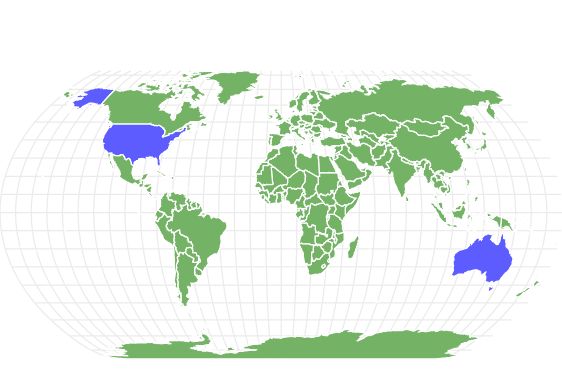Australian Shepherd
Canis lupus
Sweet, faithful and affectionate!
Advertisement
Australian Shepherd Scientific Classification
- Kingdom
- Animalia
- Phylum
- Chordata
- Class
- Mammalia
- Order
- Carnivora
- Family
- Canidae
- Genus
- Canis
- Scientific Name
- Canis lupus
Read our Complete Guide to Classification of Animals.
Australian Shepherd Conservation Status
Australian Shepherd Facts
- Temperament
- Loyal, outgoing, and friendly
- Training
- Should be trained from an early age and they are easy to train but it takes time
- Diet
- Omnivore
- Average Litter Size
- 7
Australian Shepherd as a Pet:
- General Health
- Energy Level
- Shedability
- Trainability
- Intelligence
- Tendency to Chew
- Size
- Family and kid friendliness
- Yappiness / Barking
- Moderate
- Separation Anxiety
- High
- Preferred Temperature
- Average climate
- Exercise Needs
- High
- Friendly With Other Dogs
- High
- Pure bred cost to own
- At least $600
- Dog group
- Herding
- Male weight
- 50-65 lbs
- Female weight
- 40-55 lbs
This post may contain affiliate links to our partners like Chewy, Amazon, and others. Purchasing through these helps us further the A-Z Animals mission to educate about the world's species.
View all of the Australian Shepherd images!
The Australian Shepherd is a natural herding dog that excels at whatever task it’s asked to perform.
The history of the breed dates back to the early 19th century when Basque people from northern Spain emigrated to the wide-open lands of Australia with their faithful companions, the Pyrenean Shepherds. These dogs were then crossed with several British imports (such as the Border Collie) to create an entirely new breed. After Basque people arrived in California, American ranchers took a liking to the breed and called it the Australian Shepherd.
See all of our expert product reviews.
The breed is truly an international success story, but it has a special place in American hearts since it became famous in the West. According to the American Kennel Club, it is still one of the more popular breeds in the United States. Mini and toy versions, along with the Aussie mix, have also become very popular. Other breeds with which it’s mixed include the golden retriever, poodle, corgi, and husky.
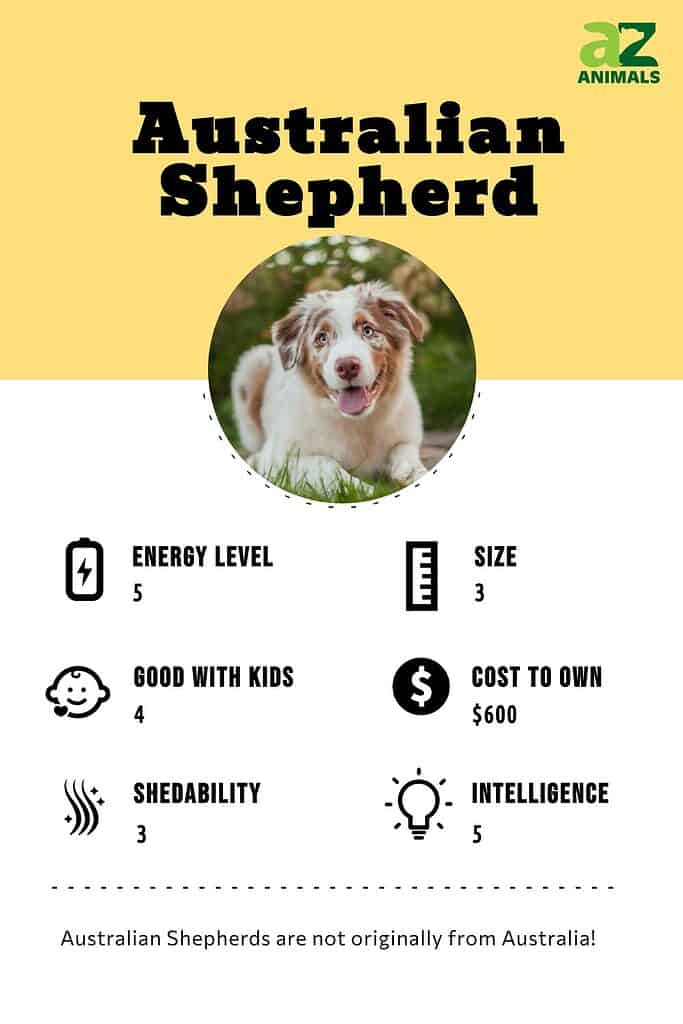
3 Pros and Cons of Owning an Australian Shepherd
| Pros! | Cons! |
|---|---|
| Fiercely loyal The Australian Shepherd develops a strong bond with its owner that won’t easily break. | Destructive behavior If this breed doesn’t have an outlet for its bundled up energy, then it may start destroying objects around the home. |
| Intelligent and hard-working This breed will complete any task or job you give it. | Territorial This breed can be a little overprotective of its owner. |
| Good exercise dog If you spend a lot of time outdoors every day, then the Australian Shepherd is an excellent companion. | Medium to high maintenance The Aussie requires a lot of time and effort to care for. |
You can also check out some incredible facts about Australian Shepherds.
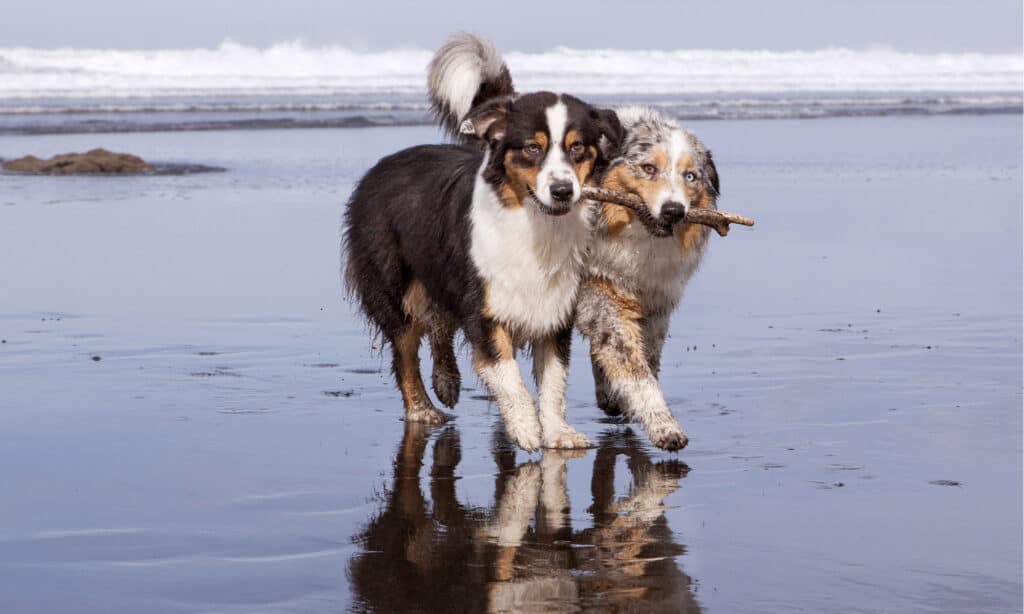
Australians Shepherds are medium to high-maintenance dogs.
©gesango16/Shutterstock.com
History and Origins
The Australian Shepherd is a descendant of Europe’s most successful herders, hailing from the Pyrenees Mountains on the border of France and Spain. The Basque people, who lived in the area centuries ago, were renowned for their herding skills and used the Pyrenean Shepherd as their go-to canine for the job, which is now known as the modern Aussie.
Health and Entertainment for your Australian Shepherd
See all of our expert product reviews.
In the early 1800s, people from England moved into the Australian interior, looking for land to raise cattle. A number of Basque shepherds also made their way to Australia, bringing their dogs with them. To improve their dogs, the Basque shepherds selectively bred them with British Collies and Border Collies. After building up their flocks, the Basque shepherds left Australia for California.
In the late 1800s, California ranchers became enamored with the herding dogs the Basques brought over, which they mistakenly thought were Australian-bred. Since then, Aussies have become a staple of the American Wild West and are now used in numerous roles, from therapy dogs to rodeo performers. The Australian Shepherd was officially recognized as an AKC breed in 1993.

The Australian Shepherd is a descendant of Europe’s most successful herders, hailing from the Pyrenees Mountains on the border of France and Spain.
©Melounix/Shutterstock.com
Size and Weight
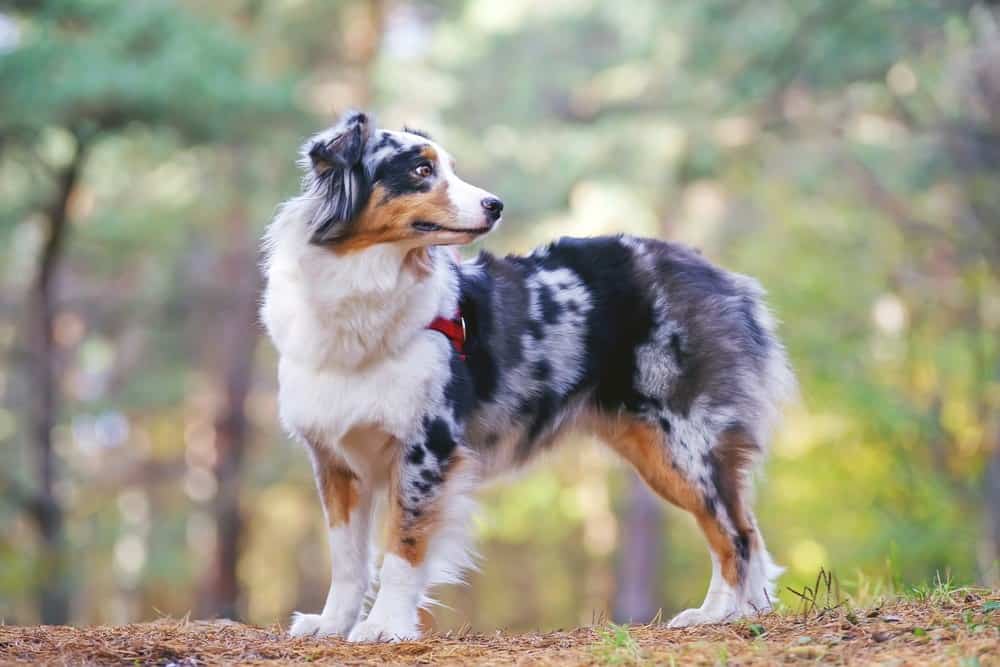
©Eudyptula/Shutterstock.com
The Australian Shepherd is a medium-sized dog with a strong build. By comparison, the mini version is around 20 to 35 pounds smaller than the standard Aussie breed, while a toy Aussie is about 12 to 17 pounds large. Here is a breakdown of the standard sizes:
| Height (Male) | 20 to 23 inches |
|---|---|
| Height (Female) | 18 to 21 inches |
| Weight (Male) | 50 to 65 pounds |
| Weight (Female) | 40 to 55 pounds |
Common Health Issues
The Australian Shepherd is a generally healthy breed, but there are a few big health issues to look out for. It is prone to several types of eye diseases, the most common of which is cataracts. This is a disease that causes a cloudy appearance in the eye. Other common health issues include hip or elbow dysplasia (a genetic abnormality that causes development problems in the joint), distichiasis (in which additional eyelashes grow around the lid and irritate the eye), deafness, hypothyroidism, allergies, drug sensitivities, and cancer.
The Aussie is also the dog breed most likely to be afflicted with epilepsy. Unfortunately, these health issues can reduce the lifespan of your pet. Because some of these health conditions arise from genetic abnormalities (particularly in merle-to-merle breeding), it is a good idea to buy the dog from a breeder that screens for these kinds of problems early. To sum up things briefly, these are the most common health problems for this breed:
- Eye Diseases
- Cancer
- Epilepsy
- Deafness
- Hip Dysplasia

The Australian shepherd is prone to several eye disorders.
©Alpeek/Shutterstock.com
Temperament
The Australian Shepherd exhibits many excellent traits that should appeal to a highly engaged owner. An ideal member of this breed has a very outgoing and friendly personality that’s keen to express itself. It should also be attentive to its owner’s commands and desires. As long as its energetic and loyal behavior is put to good use, this breed is a model dog with a good sense of self-control and diligence. Its patient demeanor also makes it a great therapy dog, drug detector, and search and rescue dog. Toy and Mini Aussies both exhibit similar behaviors as the standard breed.
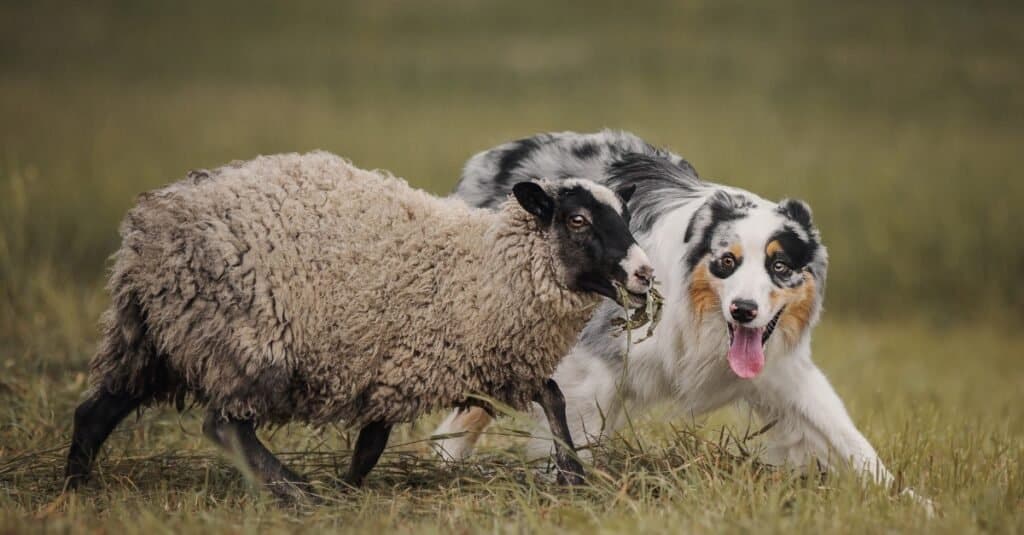
An Australian Shepherd is a natural herding dog.
©iStock.com/Julia_Siomuha
How to Take Care of Australian Shepherds
The Australian Shepherd is a moderate to high-maintenance breed that requires quite a lot of grooming, exercise, and attention. You should only buy this breed if you have the time, inclination, and ability to fully take care of it. You will get the best results if you train and socialize with this breed early as a puppy.
The Best Dog Food
A fully grown adult Aussie thrives on around 1.5 to 2.5 cups of high-quality dog food split into two separate meals every single day. It is a good idea to find specialized food for the dog’s appropriate age (puppies, adults, or seniors). Because of its tendency to gain weight, you should carefully monitor the dog’s calorie consumption and give treats only sporadically to support its training. Considering their propensity for allergies and sensitivities, Australian Shepherds may do better eating a limited ingredient or allergy care dog food.
At A-Z Animals, we think the best dog food for Australian Shepherds is Natural Balance Limited Ingredient Diet | Adult Grain-Free Dry Dog Food. We also made a list of all the best foods for your Australian Shepherd here.
This dog food is a best-seller for a reason. There is no soy, corn, or wheat, and no peas, lentils, or other legumes used for a filler that can irritate allergy-prone dogs like Australian Shepherds. And since this breed can suffer from Epilepsy, the thiamine, manganese, and copper content protects Australian Shepherds’ nervous systems. There’s taurine and Vitamin A to prevent eye problems, too.
You can find Natural Balance Limited Ingredient Grain-Free Dog Food for your Australian Shepherd here.
- No filler ingredients like corn, soy, or wheat
- Has wet and dry options
- High in protein like venison, salmon, buffalo
- Contains amino acids
Maintenance and Grooming
The Australian Shepherd has a thick double-layered coat that does require some attention. For most of the year, this breed only requires weekly brushing. But in the shedding season, the fur needs to be raked once every two or three days, followed by a quick cleanup with a wire brush. Because of its frequent outdoor adventures, the dog may require frequent baths to prevent dirt from accumulating. You should also try to keep their nails trimmed regularly.
Training
The Australian Shepherd is a highly trainable and obedient dog that easily takes to various skills, commands, sports competitions, jobs, and almost any other task you can imagine. Perhaps no other breed is quite as eager to please. One of the things you should look out for is the dog’s herding instincts. If you don’t want it herding, then you should spot the signs (such as chasing and heel sniffing) before they become more serious.
You can eliminate undesirable behavior by gently telling your dog no or walking away. You can also redirect its behavior toward more acceptable activities. Do not punish your dog by yelling at it or lashing out, even if it’s stubborn. This may discourage it or make it more distrustful of you. You can reinforce the dog’s behavior with treats or clickers. Professional training is also recommended for more serious owners.

Australian shepherds are loving and highly intelligent.
©Maria Ulzutueva/Shutterstock.com
Exercise
The Australian Shepherd is a high-energy breed that requires at least an hour or two of exercise every single day. If you already have a large yard, then you should be set, but any wide open space should suffice, and the dog should be overjoyed to come with you on walks, hikes, or biking trips. It also loves to perform tricks, agility competitions, and herding tests. The dog’s long double coat should insulate it from heat and cold, but it can become rather uncomfortable in extreme temperatures. On an exceptionally warm day, you should make sure the dog is comfortable and has enough to drink.
Puppies
There are a few things to keep in mind with your new dog. Puppies should be exposed to as many different situations and people as possible. If it’s not properly socialized from an early age, the Australian Shepherd may become wary of strangers. You should also give it an exam at the vet as soon as possible to screen for any early health problems.

Australian Shepherd puppies should be socialized early.
©zzsulc/Shutterstock.com
With Children
The Australian Shepherd is a loyal companion and excellent playmate, but the first introductions with your children should be carefully thought out and managed. Because of its herding instinct, the Australian Shepherd may at first have a tendency to chase or nip new people it encounters. Once the dog grows accustomed to your children, though, then they will get along very well with each other. In fact, this breed may become quite protective of your children. But you should teach your children never to tug at the dog’s fur or disturb it while it’s trying to eat. The Australian Shepherd can tolerate rough play, but it doesn’t want to be annoyed or harassed. It is also never a good idea to leave the dog alone with young children in case interactions go poorly.
Dogs Similar to the Australian Shepherd
The Australian Shepherd is just one of many different types of herding dogs. Here are some of the closest breeds in terms of appearance, behavior, and temperament. Some of these breeds also have their own Aussie mix.
- German Shepherd – This very large working dog, which originated from Germany, is one of the most popular breeds in the world. Like the Australian Shepherd, it is diligent, smart, loyal, and hard-working but also requires some work to fully meet its needs.
- Border Collie – Hailing from Northern England and Scotland, the Border Collie is another herding dog with a loyal personality, diligent work ethic, and energetic behavior. Its unique mixture of colors also resembles the appearance of the Australian Shepherd.
- English Shepherd – Descended from various collie breeds, the English Shepherd is a medium-sized dog with some combination of black, white, tan, or sable colors. It shares ancestry with both the Border Collie and the Australian Shepherd. This is reflected in the excellent work ethic, high intelligence, and fierce loyalty.

The Australian Shepherd is one of many types of herding dogs.
©iStock.com/Johny87
Famous Australian Shepherds
The Australian Shepherd is one of the most famous breeds in the world. It makes frequent appearances in both fiction and popular culture.
- A blue merle Australian Shepherd named Bunk was the sidekick of the cowboy actor Jack Hoxie and appeared in several films throughout the 1920s and 1930s.
- Jay Sisler, an Idaho rancher, and rodeo competitor toured the country with his popular trick-performing Australian Shepherds in the middle of the 20th century. Some of them even appeared in the Disney films Run, Appaloosa, Run and Stub, The Best Cow Dog in the West.
- Stephen Spielberg, the famous director of ET and Schindler’s List, once owned an Australian Shepherd called Harlow.
- Apple co-founder Steve Wozniak owned an Australian Shepherd (along with llamas, donkeys, and Siberian Huskies) in the 1980s. Steve Jobs supposedly owned the breed too.

A lot of celebrities have Australian Shepherds as pets.
©Bonnie van den Born, http://www.bonfoto.nlCwazi at nl.wikipedia, CC BY-SA 3.0, via Wikimedia Commons – License
Popular Names
According to the website Rover.com, these are the 10 most popular names for the Australian Shepherd:
- Luna
- Cooper
- Bella
- Charlie
- Bear
- Koda
- Sadie
- Bailey
- Milo
- Stella
Up Next
View all 194 animals that start with AAustralian Shepherd FAQs (Frequently Asked Questions)
Is the Australian Shepherd a good family dog?
The Aussie is a loyal and playful companion, but it may take some time for the dog to become accustomed to your family. Introduce the dog to your children gradually and let it know through gentle disapproval where the boundaries are.
Do Australian shepherds shed a lot?
The Australian Shepherd is a moderate shedder for most of the year, but it will need extra care in the shedding season.
Can Australian Shepherds be left alone?
Australian Shepherds should not be left alone for long periods of time. If the dog is separated from its companions, then it may start to become anxious. This can find an outlet in destructive behavior around the home.
Are Australian Shepherds easy to train?
Yes, like all herding dogs, the Australian Shepherd is easy to train. It takes to various tasks and competitions with aplomb.
What does an Australian Shepherd look like?
The Australian Shepherd has a medium-sized build, medium to long hair, and a straight back. The most common colors are solid black, solid red, blue merle, and red merle with various combinations of white and copper markings all along the body. Another appealing characteristic is the piercing brown or blue eyes, which once gave this breed the nickname of “ghost-eye dog.” It is not uncommon for this breed to have two different-colored eyes. Most dogs have a full tail, while a few have a bobbed or partially bobbed tail.
Are Australian Shepherds herbivores, carnivores, or omnivores?
Australian Shepherds are Omnivores, meaning they eat both plants and other animals.
What Kingdom do Australian Shepherds belong to?
Australian Shepherds belong to the Kingdom Animalia.
What class do Australian Shepherds belong to?
Australian Shepherds belong to the class Mammalia.
What phylum to Australian Shepherds belong to?
Australian Shepherds belong to the phylum Chordata.
What family do Australian Shepherds belong to?
Australian Shepherds belong to the family Canidae.
What order do Australian Shepherds belong to?
Australian Shepherds belong to the order Carnivora.
What genus do Australian Shepherds belong to?
Australian Shepherds belong to the genus Canis.
What type of covering do Australian Shepherds have?
Australian Shepherds are covered in Hair.
How many babies do Australian Shepherds have?
The average number of babies an Australian Shepherd has is 7.
What is an interesting fact about Australian Shepherds?
Australian Shepherds are sweet, faithful, and affectionate!
What is the scientific name for the Australian Shepherd?
The scientific name for the Australian Shepherd is Canis lupus.
What is the lifespan of a Australian Shepherd?
Australian Shepherds can live for 15 years.
What's the difference between an Australian Shepherd and an American Shepherd?
There are many differences between an American Shepherd and an Australian Shepherd. Australian Shepherds are much larger than American Shepherds, and they also have a longer lifespan.
What's the difference between an Australian Shepherd vs Blue Heeler?
There are many differences between a Blue Heeler and an Australian Shepherd. Blue Heelers have dense and thick fur, while Australian Shepherds have fluffy coats. The Australian Shepherd also lives longer than Blue Heelers on average.
What's the difference between Australian Shepherds and German Shepherds?
There are many differences between German Shepherds and Australian Shepherds. Australian Shepherds come in more colors and markings than German Shepherds, while German Shepherds grow larger than Australian Shepherds on average.
What are the key differences between Catahoula Leopard Dogs and Australian Shepherds?
The key differences between Catahoula Leopard Dogs and Australian Shepherds are origin, appearance, lifespan, temperament, trainability, and grooming.
What are the key differences between Bernese Mountain Dogs and Australian Shepherds?
The key differences between Bernese Mountain Dogs and Australian Shepherds are size, appearance, fur, lifespan, trainability, grooming difficulty, shedding level, and drooling level.
What's the difference between an Australian Shepherd vs Shetland Sheepdog?
The key differences between a Shetland Sheepdog and an Australian Shepherd are their sizes, coats, lifespans, temperaments, energy levels, and grooming needs.
What are the key differences between Australian Shepherds and Golden Retrievers?
The key differences between Australian Shepherds and Golden Retrievers are size, fur color, lifespan, temperament, energy level, barking tendencies, and shedding level.
Thank you for reading! Have some feedback for us? Contact the AZ Animals editorial team.
Sources
- American Kennel Club, Available here: https://www.akc.org/dog-breeds/australian-shepherd/

